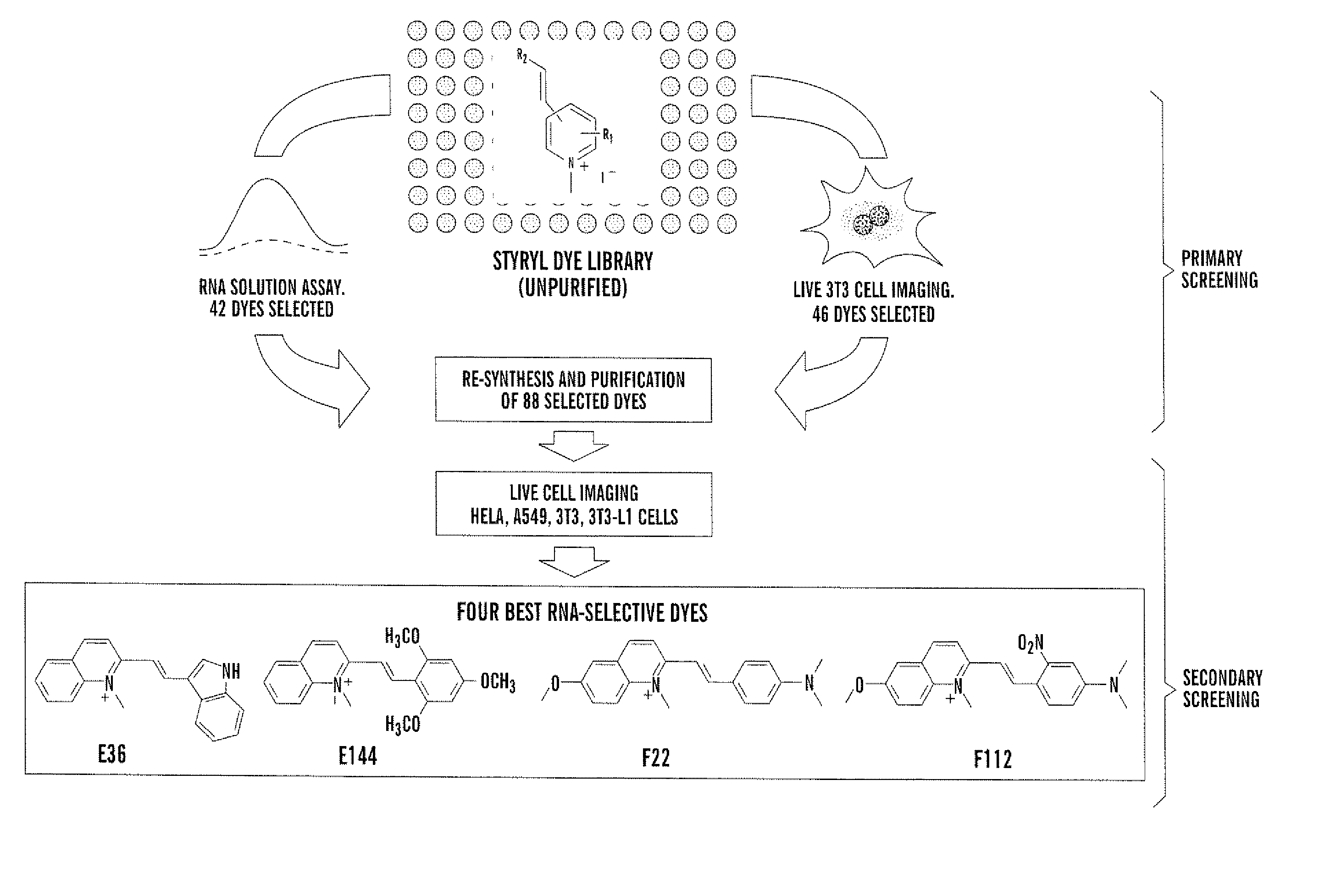RNA-selective probes for live cell imaging of nuclear structure and function
a live cell and probe technology, applied in the field of live cell imaging probes of nuclear structure and function, can solve the problems of inconvenient availability of rna-specific dyes for staining live cells, inability to widely prove their usefulness, and inability to publish their molecular structur
- Summary
- Abstract
- Description
- Claims
- Application Information
AI Technical Summary
Benefits of technology
Problems solved by technology
Method used
Image
Examples
example 1
Materials and Instruments
[0039] Unless otherwise noted, chemical materials and solvents were purchased from commercial suppliers (Sigma-Aldrich, St. Louis, Mo. and Acros, Pittsburgh, Pa.) and were used without further purification. RNA (type VI from torula yeast, Sigma) was used for primary screening. RNA, 16S- and 23S-ribosomal from E. coli, (Roche, Indianapolis, Ind.) and DNA from salmon testes (Sigma) were used for dye concentration dependency study. TE buffer (Tris-EDTA sterile solution at pH 7.5, nuclease and protease-free 0.2 μm filtered solution, GE, Piscataway, N.J.) was used in all solution experiments. A Gemini XS fluorescent plate reader was used in obtaining the excitation and emission spectra in the primary screening and titration assay studies. Greiner 96 or 384 well polypropylene black plates were used in the experiments. Full spectra data of the selected three dyes were obtained by Hitachi F-2500 fluorophotometer. Absorbance spectra were measured using SpectraMax Pl...
example 2
General Procedure for Synthesis of Building Block I
[0040] The pyridine derivative (2.04 mmol) and iodomethane (2.14 mmol) in ethyl acetate were refluxed overnight. After it was cooled to room temperature, the crystallized methylated products were filtered and washed with ethyl acetate three times and dried in vacuum.
example 3
General Procedure for Synthesis of Styryl Dye Library
[0041] Building blocks I and II were dissolved separately in absolute ethanol (100 mM) as stock solutions. In 96-well Gemini polypropylene microtiter plates, mM of each reactant, 30 μL DMSO, and 0.1 μL pyrrolidine were added using a multi-pipette. The condensation reaction was carried out in an 800 watt microwave, three minutes for each plate. Product yield and purity were identified by LCMS.
PUM
| Property | Measurement | Unit |
|---|---|---|
| Length | aaaaa | aaaaa |
| Length | aaaaa | aaaaa |
| Length | aaaaa | aaaaa |
Abstract
Description
Claims
Application Information
 Login to View More
Login to View More - R&D
- Intellectual Property
- Life Sciences
- Materials
- Tech Scout
- Unparalleled Data Quality
- Higher Quality Content
- 60% Fewer Hallucinations
Browse by: Latest US Patents, China's latest patents, Technical Efficacy Thesaurus, Application Domain, Technology Topic, Popular Technical Reports.
© 2025 PatSnap. All rights reserved.Legal|Privacy policy|Modern Slavery Act Transparency Statement|Sitemap|About US| Contact US: help@patsnap.com



